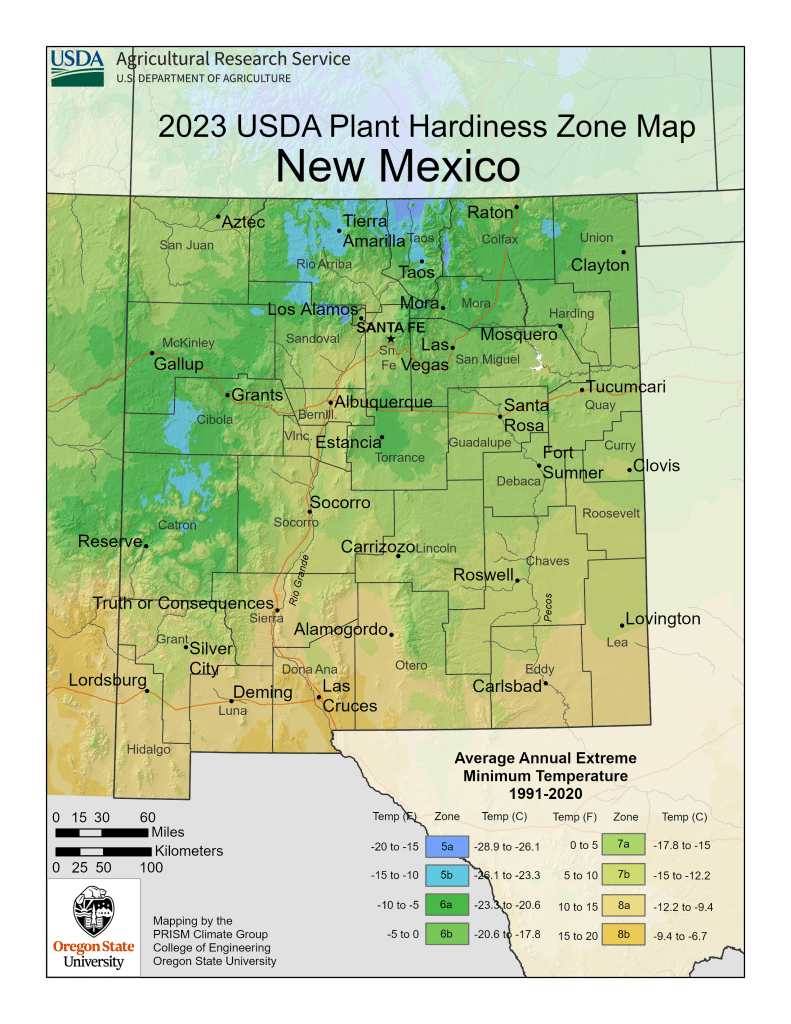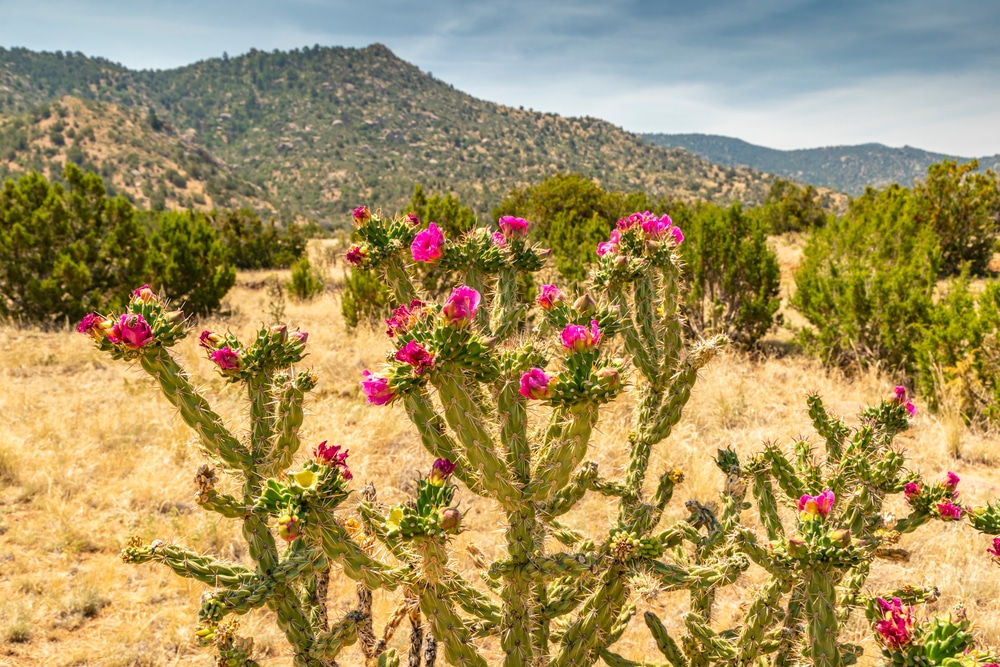New Mexico Plant Hardiness Zones

Credit to U.S. Department of Agriculture
| USDA Hardiness Zone | Average Minimum Extreme Winter Temperature Range Fahrenheit (°F)Celsius (°C) | Average Last Frost Date Range In Spring (Beginning Of The Growing Season) | Average First Frost Date Range In Autumn (End Of The Growing Season) |
|---|---|---|---|
| 5a | -20°F to -15°F -28.9°C to -26.1°C | Mid to late May | Mid to late September |
| 5b | -15°F to -10°F -26.1°C to -23.3°C | Mid to late May | Late September |
| 6a | -10°F to -5°F -23.3°C to -20.6°C | Late April to early May | Mid to late October |
| 6b | -5°F to 0°F -20.6°C to -17.8°C | Mid to late April | Late October |
| 7a | 0°F to 5°F -17.8°C to -15°C | Late March to early April | Early to mid-November |
| 7b | 5°F to 10°F -15°C to -12.2°C | Late March to early April | Early to mid-November |
| 8a | 10°F to 15°F -12.2°C to -9.4°C | Mid-March | Mid to late November |
| 8b | 15°F to 20°F -9.4°C to -6.7°C | Mid-March | Mid to late November |
New Mexico Growing Conditions

Credit to Wikipedia
General Climate
New Mexico has four distinct areas:
- The northern central mountainous region
- The eastern plains
- The northwestern plateau region
- The basin and range region south of the Rocky Mountains
The continental divide runs through the Colorado Plateau, causing water on its west to drain to the Pacific Ocean and, to the east, into the Gulf of Mexico.
The fifth-largest state in the USA, New Mexico has several different climate classifications, ranging from desert to continental to Mediterranean, but it is primarily cold and semi-arid.
Cold semi-arid climates:
- Are often in the interior of continents, far from large bodies of water
- Experience cold winters, often with snow
- Are often at higher elevations than hot semi-arid locales
- Experience a pronounced temperature variation between day and night
New Mexico temperatures peak in July, ranging from 59.5°F (15.3°C) to 88.8°F (31.6°C), and reach their lowest in January, averaging 21.7°F (-5.7°C) to 49.7°F (9.8°C).
Microclimates
USDA plant hardiness zones are an important starting point for your garden, but you’ll also need to consider microclimates.
Microclimates are areas where specific conditions create a climate different from the climate they’re situated in.
Buildings, fences, paved areas, or short hills and valleys can create these microclimates.
They can be as small as a space in your backyard or as large as a city.
In other words, learn about your local conditions from local experts to see if your garden falls into a microclimate.
Extreme Weather
Snow Storms
Snow storms can mean large amounts of potentially heavy snow on top of your plants and sustained exposure to freezing temperatures.
Snow is not likely to cause problems for your plants. Prolonged cold temperatures will, though, which is why it’s essential to choose plant varieties able to withstand them.
Insulate any newly planted perennials, shrubs, and trees before temperatures drop below freezing by doing any or all of the following:
- Wrapping them with burlap
- Watering them deeply
- Covering their roots with a layer of straw or wood chip mulch
You can also pile snow on top of your garden beds as it melts so the soil absorbs the moisture.
Thunderstorms
Several regions throughout New Mexico experience powerful thunderstorms in the spring and summer. These storms include strong winds, hail (sometimes between golf ball and baseball size), and significant rain.
As such, you’ll want to know the prevailing winds in your area. You can find this information officially by checking with your local weather authority. Or, you can ask a neighbor, “What direction do storms come in from?” It may change from season to season, but every area has its own weather patterns with which to become familiar. You’ll also want to put your garden beds in areas of your backyard that provide some protection for your plants. This could be next to existing structures or windbreaks.
Staking and supporting plants helps protect against wind damage to some extent. You can also attach sheets or floating row cover to stakes, trellises, and planting cages, which can protect against hailstorms.
Forest Fires
Dry conditions make landscapes more vulnerable to forest fires, often started by human activities. But it’s also not uncommon for fires to start from lightning strikes, either.
Forest fire season traditionally peaks in the summer, but due to the shifting climate and increased droughts, wildfires have become a persistent threat all year.
Once a forest has burned, it may not have the capacity to regrow in current conditions, leading to further desertification and even further increasing fire risks.
Fire officials in New Mexico suggest keeping the number of evergreen trees and shrubs low, planting fire-resistant plants (such as succulent ground cover), and planting at least 30 feet from your home, among other suggestions.
Growing Season
Although New Mexico is sunny, its growing season is relatively short, at approximately 150 frost-free days, though this can vary widely based on altitude.
Temperatures can vary significantly between day and night throughout the state. Select plants that can survive these fluctuations.
Use USDA data and information as a starting point and remain aware of current weather conditions. This allows you to adapt to yearly variations appropriately.
New Mexico Gardening Tips

Choose The Right Plants
In New Mexico, your plants must be able to contend with dry conditions, sometimes degraded soils, daily temperature fluctuations, and relatively commonplace extreme weather events.
Conserve Water
You can maximize your water resources in New Mexico by:
- Installing rain barrels or other water catchment systems
- Installing drip irrigation systems
- Growing drought-tolerant plants is also helpful
- Practicing efficient watering by watering low to the ground, underneath plant foliage, watering early in the day and deep watering once a week.
- Mulching
Mulch
You can improve your soil structure by adding layers of organic materials such as compost, straw, grass clippings, or wood chips as mulch.
Mulch helps your soil retain water while breaking down and adding nutrients that help your plants flourish. It also enhances the quality of your soil and allows it to absorb and retain water more easily.
This is particularly important in New Mexico, where soils are degraded and compacted by many seasons of erosion and drought. Mulch prevents further soil degradation, and both builds and protects the soil ecosystem.
Mulch benefits your garden by:
- Recycling nutrients
- Improving soil quality as it breaks down
- Retaining water in the soil
- Suppressing weeds
- Protecting plant roots from heat damage or stress
- Inviting healthy garden predators that will keep pest populations down
Consult With Local Professionals
Consulting with local gardening professionals allows you to benefit from their experience with your area’s conditions, the plants that do well there, and overall best practices.
New Mexico Plant Suggestions

Trees
- Quaking Aspen (Populus tremuloides)
- Desert Willow (Chilopsis linearis)
- Arizona Sycamore (Platanus wrightii)
Shrubs
- Creosote Bush (Larrea tridentata)
- Juniper (Juniperus communis)
- Curl Leaf Mountain Mahogany (Cercocarpus ledifolius)
Flowers
- Parry’s Penstemon (Penstemon parryi)
- Moonshine Yarrow (Achillea “Moonshine’)
- Blanketflower (Gallardia aristata)
Vegetables
- Okra (Abelmoschus esculentus)
- Garbanzo Bean (Cicer arientinum)
- Cucumber (Cucumis sativus)
Herbs
- Basil (Ocimum basilicum)
- Fennel (Foeniculum vulgare)
- Sage (Salvia officinalis)
Spices
- Chile (Capsicum annuum)
- Mustard Powder (Sinapis alba)
- Cumin (Cuminum cyminum)
Fruits
- Pecans (Carya illinoinensis)
- Boysenberries (Rubus ursinus x idaeus)
- Sour cherries (Prunus cerasus)
Succulents
- New Mexico Century Plant (Agave americana)
- Yucca (Yucca filamentosa)
- Cholla cactus (Cylindropuntia sanfelipensis)
Disclaimer
Any of the above can change and is not exhaustive.
Treat anything above like a good starter guide. Then use that as a foundation as you consult with local gardeners, professionals, forecasts, guides, and organizations.

